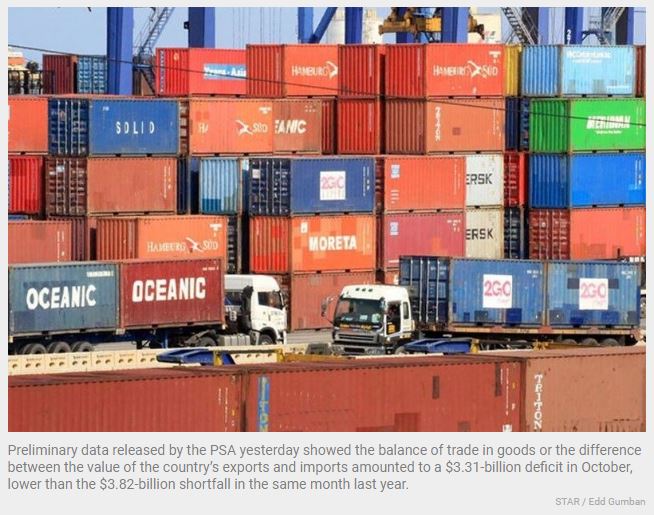Philippines: Trade gap narrows in October
MANILA, Philippines — The country’s trade gap continued to narrow in October as exports rose while imports grew at a slower pace, the Philippine Statistics Authority (PSA) said.
Preliminary data released by the PSA yesterday showed the balance of trade in goods or the difference between the value of the country’s exports and imports amounted to a $3.31-billion deficit in October, lower than the $3.82-billion shortfall in the same month last year.
The October trade deficit is also smaller than the $4.84-billion trade gap in September.
Rizal Commercial Banking Corp. chief economist Michael Ricafort said in a commentary yesterday that the narrower trade deficit was “largely brought about by the new record high for exports on a monthly basis.”
He said imports also eased to eight-month lows.
PSA data showed the country’s merchandise exports increased by 20 percent year-on-year to $7.7 billion in October, faster than the two percent growth in the same month a year ago.
The country’s exports also grew at a faster pace compared to the 7.1 percent uptick posted in September.
Of the top 10 major commodity exports, three registered increases in October: electronic products (39.6 percent); ignition wiring set and other wiring sets used in vehicles, aircrafts and ships (26.1 percent), and machinery and transport equipment (1.9 percent).
Ricafort said disruptions in the global supply chains may have provided opportunities for increased demand for some Philippine exports.
Data showed the country’s imported goods went up by 7.5 percent year-on-year to $11 billion in October. The growth was slower than the 22.8 percent hike in the same month last year, and the 14.4 percent increase in September this year.
PSA attributed the growth in imports in October to five major commodity groups that had higher import values: metalliferous ores and metal scrap (462.7 percent), transport equipment (46.3 percent), other food and live animals (40.3 percent), mineral fuels, lubricants and related materials (29.7 percent) and miscellaneous manufactured articles (10.2 percent).
“Imports could have been partly slowed by higher prices or inflation, still relatively weaker peso earlier in recent months that increased importation costs or prices, as well as higher interest rates (higher borrowing costs or financing costs) locally and worldwide, in terms of higher input costs or prices,” Ricafort said.
The Philippines’ total external trade in goods reached $18.7 billion in October, 12.3 percent higher than the $16.65 billion in the same month last year, but lower than the $19.17 billion in September this year.
From January to October, the country’s trade deficit reached $49.98 billion, wider than the $32.4 billion in the same period last year.
Given the monthly average trade deficit of about $5 billion in the first 10 months of the year, Ricafort said the full-year trade gap could reach around $60 billion.
The country’s total export earnings amounted to $66.01 billion during the period, up 6.3 percent from the $62.10 billion the previous year.
Goods imported by the Philippines, on the other hand, climbed by 22.7 percent to $116 billion.
Source: https://www.philstar.com/business/2022/12/14/2230615/trade-gap-narrows-october-


 English
English




